Fiona Ingram's Blog, page 30
December 6, 2018
Book Review: The Mystic Video Game
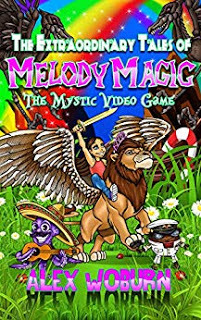 The Extraordinary Tales of Melody Magic: The Mystic Video Game by Alex Woburn is the third book in this series, filled with color, magic, action, danger, ghastly monsters, fun and whimsical creatures, and lots of adventure. Melody and her mom, Violet, find themselves homeless after their house was burned down. While Melody stays with her friend Max, Violet gets a job helping to clean up a charming cabin in the woods and is able to live there while doing so. The owner, Saxon, and his son, Charlie, just disappeared many years ago, and Dante, Saxon’s brother, has finally decided to tidy things up and put the cabin on the market. Melody and her friends decide to help Violet, but while cleaning up they discover a very old video game console … and are invited into the World of Whimsy by Ollie, the singing octopus. The kids need to help save the World of Whimsy from great evil. Will they survive the terrible dangers contained within the game? Are they ready for the incredible surprises waiting there?
The Extraordinary Tales of Melody Magic: The Mystic Video Game by Alex Woburn is the third book in this series, filled with color, magic, action, danger, ghastly monsters, fun and whimsical creatures, and lots of adventure. Melody and her mom, Violet, find themselves homeless after their house was burned down. While Melody stays with her friend Max, Violet gets a job helping to clean up a charming cabin in the woods and is able to live there while doing so. The owner, Saxon, and his son, Charlie, just disappeared many years ago, and Dante, Saxon’s brother, has finally decided to tidy things up and put the cabin on the market. Melody and her friends decide to help Violet, but while cleaning up they discover a very old video game console … and are invited into the World of Whimsy by Ollie, the singing octopus. The kids need to help save the World of Whimsy from great evil. Will they survive the terrible dangers contained within the game? Are they ready for the incredible surprises waiting there? Since this is the third book, young readers might like to pick up the first two books to acquaint themselves with Melody’s story and how she got her powers. However, since Alex Woburn drip-feeds backstory into the rollicking adventure as it unfolds, there is enough detail to keep readers apprised. The story is a non-stop, helter-skelter ride that whisks young readers headlong into a world of magic and mayhem. The author has an incredible imagination and kids will just love the amazing creatures – both the frightening and then fun ones - he has created. Ollie the singing octopus is just adorable. There are numerous life lessons and messages interwoven into the action and the encounters Melody and her friends have with the real world and the magical one. Teamwork, accepting others for who they are, being kind to others, believing in yourself, looking for answers from within, caring for the environment, and many more.
The author sets the scenes in the real world very well, with Melody’s school and social life nicely outlined. Young readers will relate to the teachers and the mean girl scenario. The entry into the magical World of Whimsy is done in a way that reminded me of the movie Jumanji, where the kids get to choose various powers. These powers are suited to their personalities. The question of would anyone really want superpowers in their daily life is addressed in an interesting way at the end. The story wraps up nicely with, of course, a new adventure looming as Violet takes a job helping the owner of a creepy old mansion turn it into a lovely hotel… A wonderful tale for young readers who love adventure and action stories with a difference!
Published on December 06, 2018 07:15
November 30, 2018
Book Review: Johnnie Mr. Tough Guy
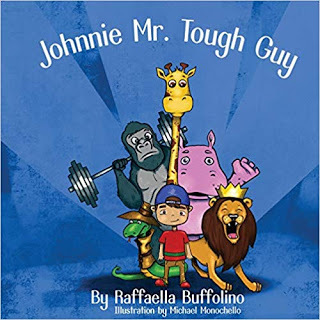 Johnnie Mr. Tough Guy is an adorable children’s picture book written by Raffaella Buffolino and illustrated by Michael Monochello. Johnnie was a tough little guy, and he wasn’t afraid of anything – bugs, storms, monsters, not even the kid next door. When his mom says they’re going to visit the zoo that day, Johnnie decides to find an animal there that’s as tough as he feels he is. They went early and so there were no crowds and long lines of visitors. Johnnie and his mom had the place to themselves. Johnnie visits a number of exhibits – the lion, the gorilla, the giraffe, the snakes, the elephants, the hippos – and tries to decide who is the toughest guy there… He thought about what the zookeeper said about the lion; even in a cage, the lion was still the king. Johnnie wonders if he is the king of the house, like the lion?
Johnnie Mr. Tough Guy is an adorable children’s picture book written by Raffaella Buffolino and illustrated by Michael Monochello. Johnnie was a tough little guy, and he wasn’t afraid of anything – bugs, storms, monsters, not even the kid next door. When his mom says they’re going to visit the zoo that day, Johnnie decides to find an animal there that’s as tough as he feels he is. They went early and so there were no crowds and long lines of visitors. Johnnie and his mom had the place to themselves. Johnnie visits a number of exhibits – the lion, the gorilla, the giraffe, the snakes, the elephants, the hippos – and tries to decide who is the toughest guy there… He thought about what the zookeeper said about the lion; even in a cage, the lion was still the king. Johnnie wonders if he is the king of the house, like the lion?This is a delightful book that gives children food for thought as Johnnie examines each animal and comes to his conclusion about it. I liked that Johnnie had his own opinions and related each animal to his own experiences or people in his life. The illustrations are well done and brightly colored, the type that grabs a young reader’s attention and makes them want to discover more. The images above each actual animal image are just wonderful and I loved the imaginative take on the rat and the snake. There is a lot for children to explore in each illustration and these offer topics for discussion. Parents and teachers can use this book for further discussion, as well as some research into wildlife. This is a delightful, deceptively simple tale that offers youngsters a lot more than at first glance.
Published on November 30, 2018 23:55
November 17, 2018
Book Review: The Fox and the Train
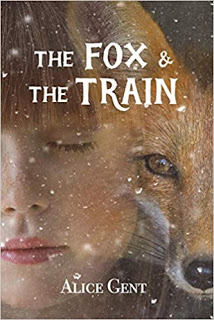 The Fox and the Train
by Alice Gent is hard to define by genre. Part fable, part folk story, part allegory, part fairy tale. From the first page, the reader is invited into a world of magic and the seemingly impossible. “For we have some flax golden tales to spin…” From that moment I knew I would love this tale of the fox and the train. The story is set some time in the last century, and there is a war and hardship. Thirteen-year-old Anna has lost her father, but he was “lost” from the time of the previous “Old War” anyway. With the help of her grandmother, Anna cares for her mother, whose memories have been stolen by “the black foxes.” Her brother Anderson is away fighting on the front, and her other brother, Michael, works on the mine. Bad news comes of the cave-in at the mine. When the train and the tracks are damaged by a treefall, someone must go on foot to help the miners. Anna decides to go with her friend, Benny, who is clever and strange and not like other people. However, to get to the mines, their journey takes them into the magic, danger, and darkness of the woods, the home of the Spirit King.
The Fox and the Train
by Alice Gent is hard to define by genre. Part fable, part folk story, part allegory, part fairy tale. From the first page, the reader is invited into a world of magic and the seemingly impossible. “For we have some flax golden tales to spin…” From that moment I knew I would love this tale of the fox and the train. The story is set some time in the last century, and there is a war and hardship. Thirteen-year-old Anna has lost her father, but he was “lost” from the time of the previous “Old War” anyway. With the help of her grandmother, Anna cares for her mother, whose memories have been stolen by “the black foxes.” Her brother Anderson is away fighting on the front, and her other brother, Michael, works on the mine. Bad news comes of the cave-in at the mine. When the train and the tracks are damaged by a treefall, someone must go on foot to help the miners. Anna decides to go with her friend, Benny, who is clever and strange and not like other people. However, to get to the mines, their journey takes them into the magic, danger, and darkness of the woods, the home of the Spirit King.The descriptions are detailed, intense, and lyrical, giving an immediacy that draws the reader right into Anna’s experiences. The first part of the book is quite realistic with hints of magicality and the pace is slow as the author sets the scene of Anna’s life and the events leading up to the tragedy of the mine collapse and the damage to the train tracks. The second half dramatically speeds up the chain of events as it plunges the reader and Benny and Anna into a world that isn’t quite real. One wonders if Anna’s visions of the Spirit King, in the form of a fox, are perhaps hallucinations from the cold and hunger. The pace becomes quite frantic as the two teens must combat fatigue, cold, hunger, the environment, and enemy soldiers. The story itself is fascinating as the reader is taken along with Anna in her quest, both internal and external, and in her being able to overcome the tests presented to her. I found myself completely absorbed in the unfolding of events and I loved the appearance of the Spirit King.
I am not very fond of present tense in a story but somehow this works in The Fox and the Train. There is a lot of telling as the author sets the scene, which I find did slow things down a bit, and perhaps it would have been better for the reader to work out the meaning behind the apparitions of the Spirit King. However, the author has delved into many themes that will resonate with readers and perhaps the most important message to take from this story is the power of love, and how courage comes from the most surprising places.
Published on November 17, 2018 23:53
November 7, 2018
Q and A with Author Cheryl Carpinello
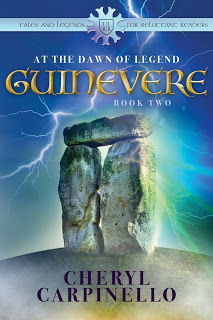 Please welcome my friend and fellow author Cheryl Carpinello to my blog today.
Please welcome my friend and fellow author Cheryl Carpinello to my blog today. I have read and reviewed and loved both Cheryl’s Arthurian books, and so I decided to do a little Q and A to get behind the scenes and the characters in Guinevere: At the Dawn of Legend.
Although Guinevere is only 15, still a young girl, how seriously does she take her future duties as queen?
Guinevere, not yet married to Arthur, still enjoys the freedom of being herself. At 15, most of the time she doesn’t think beyond the current day. And since her father and Arthur are up north away from the castle, she really has no one to answer to although Brywyn, Cedwyn’s mom, still exercises some authority over her. Cedwyn lets us know in the beginning of the book that his ma will not approve of their adventure to the magical stones. It is when the consequences of her actions come crashing down around her that she remembers who she is supposed to be. That’s when she remembers the story of the Red Deer and the Unicorns. In return for saving for red deer, those creatures save the unicorns. She understands then that her role is to protect her people.
How does she ‘learn’ to become queen? What would her daily duties be and her ‘future queen duties’ be?
Behind the pages of the story, Brywyn, Cedwyn’s mom, is teaching her. Brywyn has taken care of the castle for many years since the death of Guinevere’s mother when Guin was young. Besides taking care of the Keep where she and her father live, Guinevere is still in ‘school’ and learning math, Latin—and possibly a little Spanish and French—to be able to talk with visiting rulers from Gaul and other countries when she is queen.
How important is Cedwyn to her and why?
Cedwyn has been her constant companion and friend forever. He was raised alongside Guinevere since his ma worked closely with King Leodegrance. They are closer than a sister and brother. Because Cedwyn’s dad is a knight, he understands more than Guinevere about what his role in life will be. He knows how unpredictable adventures with Guinevere can be, but still goes along with her. This is for two reasons: one, he enjoys the adventures, and two, he also knows that he is to be her protector when he becomes a knight.
What role does Merlyn play in her life?
Merlyn acts as a second father and friend, and as her teacher. He has been around since she can remember. The times when her father hasn’t been around, Merlyn was there. Guinevere was able to talk with him and ask questions about her future. As her teacher, Merlyn’s way was subtle. He let her discover the meanng behind Nimue and the unicorn’s passing in On the Eve of Legend. He also guided her in understanding the lesson behind the red deer and the unicorns. We will see further lessons from him in Book 3, Guinevere: The Legend.
Amazingly, Cedwyn repeats word for word what the goddess said. Does he have a photographic/eidetic memory?
No, he does not. What he does have is the huge impression the goddess had on him at the Stones. And it doesn’t hurt to have a little of the goddess’ magic. The goddess obviously thought her message important enough to burn it in Cedwyn’s memory.
What would daily life at the monastery be like?
In the 400-500’s, life as a monk would have been terribly simple compared to today. Their duties would include spreading the word of the new religion as they could. It would have been a life with little in the way of luxuries. Winters would have meant long hours spent at the abbey with few visitors. They grew what food they could mostly vegetables. Hunting would have provided meat. The orchards surrounding my particular abbey provided fruits. They would have worked hard to make friends in the area because of the prevailing belief in the goddess. They did this by trading foodstuffs with the residents of the castle and providing what assistance they could.
Although this is Guinevere’s story, it seems to be more like Cedwyn’s coming of age story?
At the Dawn of Legend is Cedwyn’s story much more than Guinevere’s. While they both grow up, it is Cedwyn who determines his course of action before he and Guinevere try to save the kids. His main concern is that he protects Guinevere.
[Cedwyn] kept watch and formulated his own rescue plan. It was dangerous, and neither Guinevere nor his ma would like it. That’s why he’d say nothing to either of them. Sometimes a knight had to keep his own counsel and just do what had to be done.
While he will continue to grow up in book 3, Guinevere will catch up to him, I hope.
How dangerous was life back then?
Life back then was as dangerous as any time. Compared to today, it might have even been safer. But aside from that, Britain was in a struggle between local kings and the remnants of the Roman occupation. Renegades roamed the isle, robbing and creating havoc. Local leaders carried the reminder of the Roman occupation and were not eager to offer allegiance to a new leader, Arthur. Thus, the young king would have had a tough time convincing them to join him. Most of these skirmishes would have taken place in the north away from Guinevere’s home in the south.
Will Cedwyn have the courage to follow through with his plan to save the children?
I almost answered this one, Fiona! Everyone is going to have to wait for book 3 to answer this question. I hope to have Guinevere: The Legend out for Christmas 2019.
What is Guinevere’s finest quality? What is Cedwyn’s finest quality?
I believe Guinevere’s finest quality will be what her father has always told her not to do.
…[K]ings must rule with their heads not their hearts.
Even in the toughest times in front of her, Guinevere will rule from her heart first.
For Cedwyn, it is his undying loyal to his friend and his queen.
Sitting there he remembered their adventures. The unicorns, the painted dragon, King Pellinore, the bratchet, and the wild boar…This was real. This was what the goddess meant…Cedwyn wiped a tear from his eye and squared his shoulders…He wondered if he would see her again.
About Cheryl: Cheryl Carpinello is an author, retired high school English teacher, and Colorado native. Since retiring from teaching, she's been able to devote her time to writing and traveling. Although she may be away from teaching, she is still a teacher at heart and especially enjoys meeting with kids and talking with them about reading and writing. Cheryl hopes through her books she can inspire young readers and young-at-heart readers to read more. Visit Cheryl's website for more on this author and her books!
Published on November 07, 2018 22:50
October 29, 2018
Book Review: Moscow Airlift
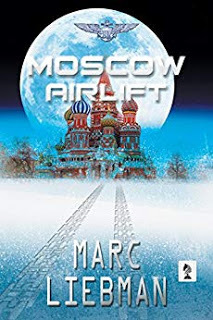 Although many people are probably unaware of this fact, by 1991 and for several reasons the Soviet Union had run out of grain. Faced with the threat of a starving population and mayhem, Gorbachev signed a deal with the USA, committing them to purchasing 8 million tons of grain over the next five years. World powers were then, and even more now, so finely balanced that the collapse of any country was not desirable. This one would send millions of starving Russian refugees fleeing to other countries. But the Soviets have more than just a food problem. Inflation rises, rumblings of dissent sound from within the ranks of the powers that be, and Gorbachev faces a coup. This is the perfect moment for Iran to illicitly obtain nuclear weapons. Seasoned Captain Josh Haman is sent by the US government to be their eyes and ears on the ground, and to submit accurate intel on the situation. But his impersonal attitude ends when he meets a KGB general who promises to give him the names and addresses of the man who ordered the killing of his first wife and her parents. Josh is torn between his military goals and the personal desire to exact revenge. Plus, he meets a former flame from the past! Adding to that is a radicalized mole in the FBI and a bomb threat in New York…
Although many people are probably unaware of this fact, by 1991 and for several reasons the Soviet Union had run out of grain. Faced with the threat of a starving population and mayhem, Gorbachev signed a deal with the USA, committing them to purchasing 8 million tons of grain over the next five years. World powers were then, and even more now, so finely balanced that the collapse of any country was not desirable. This one would send millions of starving Russian refugees fleeing to other countries. But the Soviets have more than just a food problem. Inflation rises, rumblings of dissent sound from within the ranks of the powers that be, and Gorbachev faces a coup. This is the perfect moment for Iran to illicitly obtain nuclear weapons. Seasoned Captain Josh Haman is sent by the US government to be their eyes and ears on the ground, and to submit accurate intel on the situation. But his impersonal attitude ends when he meets a KGB general who promises to give him the names and addresses of the man who ordered the killing of his first wife and her parents. Josh is torn between his military goals and the personal desire to exact revenge. Plus, he meets a former flame from the past! Adding to that is a radicalized mole in the FBI and a bomb threat in New York…Besides being a political thriller to satisfy even the most exacting of fans, Moscow Airlift by Marc Liebman is fascinating reading on world affairs. Although the title is Moscow Airlift, and the operation is named Operation Deny Famine, the action starts in 1971, in war-torn Laos. It moves over the years between Russia, France, the USA, Iran, Israel, Lebanon, Azerbaijan, Turkmenistan, and Uzbekistan. The narrative is detailed, perhaps overly so for fans who like to race through the action, but is perfect for those readers who enjoy savoring facts and minutiae. The author’s style is somewhat reminiscent of Frederick Forsyth, John le Carré and Terry Hayes. I am a huge fan of Hayes’ and Forsythe’s work and I appreciated this element of Marc Liebman’s tale.
The action starts at a time and place and involving characters that seem unrelated to the main actor and his mission. But be patient. Liebman weaves an intricate web of espionage and treachery, covert action and duplicity. All the threads, sub plots, and seemingly disparate characters are drawn together inexorably. The narrative is detailed, informative and succinct, yet the story flows without dragging. Liebman keeps the reader intrigued and reading on by changing the various scenarios quickly and this creates tension and interest. The author’s extensive military experience shows through in the story and plot.
There are too many characters to bond deeply with each of them, but Josh is the most well developed and necessarily so as he is the pivot around which the action turns. Danielle is also a character that readers will care about. The others are well drawn within their roles. Despite being a complex story with much to keep track of, Moscow Airlift was a surprisingly easy read. The historical background on Moscow Airlift, found at the end of the book, is well worth reading in advance. I enjoy political thrillers and especially when facts are woven carefully into a thrilling plot, which is the case here. For fans of the genre, this is an excellent reading choice.
Published on October 29, 2018 11:00
October 15, 2018
Book Review: The Language Thieves
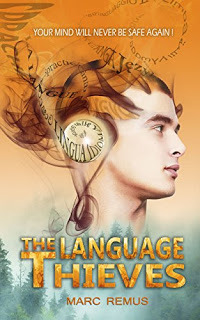 The Language Thieves is a young adult fantasy by Marc Remus. Sixteen-year-old Daniel is none too happy about his father’s decision to move the family from Arizona to a remote Scottish island, of all places. His mother was stricken by a mysterious illness that has rendered her incapable of communication. Daniel speaks English and Irish Gaelic although he isn’t too keen on overtly displaying his Irish roots. Once on the island, he meets two new friends, Jenny and Connor, who are as suspicious as he is about a strange, elusive tribe that inhabits a part of the island: the Cerebrals, with their own unique culture, obsession with language, and their worship of the brain. The Cerebrals keep themselves apart from the rest of the population, and don’t want their kids to have anything to do with the locals. A bit difficult when Daniel finds himself falling for the cute Emily, who just happens to be a Cerebral. What is the mystery behind the Cerebrals, and do they have anything to do with Daniel’s mom’s affliction? How can they possibly be dangerous?
The Language Thieves is a young adult fantasy by Marc Remus. Sixteen-year-old Daniel is none too happy about his father’s decision to move the family from Arizona to a remote Scottish island, of all places. His mother was stricken by a mysterious illness that has rendered her incapable of communication. Daniel speaks English and Irish Gaelic although he isn’t too keen on overtly displaying his Irish roots. Once on the island, he meets two new friends, Jenny and Connor, who are as suspicious as he is about a strange, elusive tribe that inhabits a part of the island: the Cerebrals, with their own unique culture, obsession with language, and their worship of the brain. The Cerebrals keep themselves apart from the rest of the population, and don’t want their kids to have anything to do with the locals. A bit difficult when Daniel finds himself falling for the cute Emily, who just happens to be a Cerebral. What is the mystery behind the Cerebrals, and do they have anything to do with Daniel’s mom’s affliction? How can they possibly be dangerous?This is a young adult fantasy that is quite different from the norm. The plot dives back into ancient history and draws together some very intriguing theories. Young adult fans of Atlantis and ancient civilizations will devour this story. The plot is full of twists and turns and although I am not usually surprised, this book made me sit up. The action starts right away, aboard the ferry en route the island, when a young teen is attacked by strange men. The pace is steady and escalates as the youngsters team up to resolve the mystery behind the Cerebrals, their mission, and how it will affect the whole world.
Daniel is the most well developed of the trio, but Jenny is a solid sidekick gifted with IT skills and Connor is close behind as the loyal friend willing to follow first and ask questions later. The teens sound and behave mostly as one would expect teens to do and this adds realism to the plot. The romance between Daniel and Emily is sweet but underplayed so that it does not overshadow the main plot. The intrigue and mystery behind what the kids discover will certainly have young readers doing their own investigations into history, culture, and the value and place of ancient languages in society. I liked this thought-provoking angle – just how many ancient languages are still spoken today, and how many have been lost in the last century? The descriptions of the Cerebrals and their culture, dress and architecture are unique and showcase the author’s incredible imagination. A great cover and good layout and editing add to one’s reading pleasure. Themes of friendship, loyalty, teamwork and family abound. This is an intriguing fantasy by Remus and perfect for the young adult market.
Published on October 15, 2018 06:15
March 19, 2018
Book Review: Queen Mary's Daughter
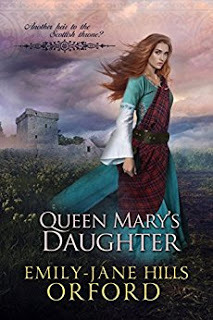 Do you know your history? Do you know your Scottish and English history, to be exact? In a story that starts in 2016, and jumps back in time to 1567, the reader is taken along with Mary Elizabeth Stuart as she discovers her heritage, meets her true mother, has to make decisions that could change the course of history… and finds out why her grandmother insisted she make a trip from Toronto to Kinross, a tiny little Scottish village, to understand her role in life, both here and back in the sixteenth century. Open
Queen Mary’s Daughter
by author Emily-Jane Hills Orford for more!
Do you know your history? Do you know your Scottish and English history, to be exact? In a story that starts in 2016, and jumps back in time to 1567, the reader is taken along with Mary Elizabeth Stuart as she discovers her heritage, meets her true mother, has to make decisions that could change the course of history… and finds out why her grandmother insisted she make a trip from Toronto to Kinross, a tiny little Scottish village, to understand her role in life, both here and back in the sixteenth century. Open
Queen Mary’s Daughter
by author Emily-Jane Hills Orford for more!What a story! I absolutely loved it from start to finish. For fans of historical novels, historical romances, modern romances, time travel, alternative history, and a bit of mystery thrown in, the book has a lot to offer a variety of readers. Time travel has never really been explained (except by writers) and is not an exact science (as scientists would be the first to declare), but in this story that spans centuries, the author’s concepts work very well, and readers are never in the dark. The ramifications of time travel, the effects of the past on the future and vice versa are also explored. The characters are well defined, and their actions and ambitions make sense. For anyone who takes an interest in the Brexit question, and Scotland’s determination to break away from Britain, regain independence, and remain in the EU, this is a theme that has ramifications stretching back into history. I enjoyed how a modern theme had its roots in the past. Very cleverly done by the author.
I have Scottish heritage and I really appreciated the descriptions of the settings, and I’d love to visit Mrs D’s B&B as well. Mary Elizabeth is a likable heroine with a huge burden placed upon her shoulders. Historical facts are woven into the narrative very naturally, informing the reader without overwhelming them. History buffs will love the detail. Bigger themes than just love and romance, time travel, and historical references abound; what if the fate of your society, your country, rests upon you giving up your own desires and decisions to fulfil a role thrust upon you?
I enjoyed this story so much. The author has the ability to make the reader time travel with the characters. In fact, I found myself asking the same questions that Mary Elizbeth asked. “So many questions; so few answers.” Sometimes British history can be confusing, with similar names, kings, queens, marriages, alliances, treachery and more. With extensive and meticulous in-depth research and consummate skill, author Emily-Jane Hills Orford makes this all read very easily, and one is never in any doubt as to who is who in the grand picture. There is a wonderful twist at the end of the tale that should delight fans of conspiracy theories as well. A most enjoyable book!
Published on March 19, 2018 09:35
March 3, 2018
Book Review: Lucy's First Christmas
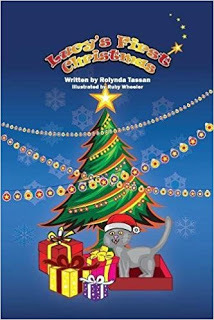 Lucy’s First Christmas
is the third book in the Lucy Tales series, written by Rolynda Tassan and illustrated by Ruby Wheeler. Lucy is a rescue cat who now lives with a lovely family, comprising Mom, Dad, youngster Ben and other animals, Sissy, Addy, and Pippin. Something’s up in the household with Mom baking cookies, Dad fixing the lights for the Christmas tree, and Ben outside building a snowman. All this unusual activity puzzles Lucy. The other animals tell Lucy that since the next day is Christmas Day, Santa will be visiting that night to drop off presents for everyone. Everyone is busy with activities, getting ready for the holiday, and Lucy wants to help. But a little kitten can’t exactly help to wrap the presents and untangle the Christmas lights, and outside in the snow Lucy manages to fall into a snowdrift. What can Lucy do to help everyone get ready for the festivities? One thing Lucy does very well is snuggle, and that’s how she found a way to help everyone by tucking them into bed on Christmas Eve.
Lucy’s First Christmas
is the third book in the Lucy Tales series, written by Rolynda Tassan and illustrated by Ruby Wheeler. Lucy is a rescue cat who now lives with a lovely family, comprising Mom, Dad, youngster Ben and other animals, Sissy, Addy, and Pippin. Something’s up in the household with Mom baking cookies, Dad fixing the lights for the Christmas tree, and Ben outside building a snowman. All this unusual activity puzzles Lucy. The other animals tell Lucy that since the next day is Christmas Day, Santa will be visiting that night to drop off presents for everyone. Everyone is busy with activities, getting ready for the holiday, and Lucy wants to help. But a little kitten can’t exactly help to wrap the presents and untangle the Christmas lights, and outside in the snow Lucy manages to fall into a snowdrift. What can Lucy do to help everyone get ready for the festivities? One thing Lucy does very well is snuggle, and that’s how she found a way to help everyone by tucking them into bed on Christmas Eve.This is an adorable story with a deeper meaning for families, their animals, and the love and warmth of the Christmas spirit. The book is dedicated to the shelter and rescue volunteers who embrace those animals waiting for their forever families. Lucy finds love and warmth in a family that cares for her. The Christmas theme, with giving and caring for others, is one that youngsters will appreciate as well. The idea of the family preparing for a holiday together, everyone doing the tasks that they do best, spending time together as a family by reading a Christmas story aloud in front of the tree, giving gifts and making sure that everyone feels as if they are a special part of the celebrations will enchant young and older readers alike. The illustrations are delightful, simple, and colourful, and convey the ideas expressed in the text. Each panel is very clear, and this is a good opportunity for young readers who are reading with a parent or caregiver to discuss the picture in depth. This lovely, charming story is the perfect read for Christmas or any time of year and is sure to bring joy to young readers for many more years to come.
Published on March 03, 2018 07:33
February 15, 2018
Book Review: Boudin's First Christmas
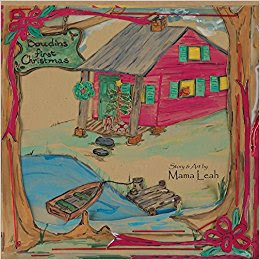 Boudin's First Christmas
is the first story in Boudin's Grand Adventures, and is written and creatively illustrated by Leah Morris, or “Mama Leah.” This is a simple and delightful children’s picture book story of a grandmother now left alone after a long and happy marriage to her husband of sixty years. Together they had made the bayou their home and had enjoyed life there and exploring what the swamp had to offer. But the old lady is lonely and longs for a companion to share her days. Maybe a dog? A dog could keep her company as she went on walks. So, in anticipation of her wish being granted, the old lady set out a comfy chair for Father Christmas, cookies, and a cool glass of milk. She also placed a candle in the window to light his way. As the sun rose on Christmas Day, what a wonderful, loving surprise awaited her! The old lady named her adorable new companion Boudin, which is the name of a sausage of meat and rice really enjoyed by the Cajun French. Boudin’s adventures have just begun.
Boudin's First Christmas
is the first story in Boudin's Grand Adventures, and is written and creatively illustrated by Leah Morris, or “Mama Leah.” This is a simple and delightful children’s picture book story of a grandmother now left alone after a long and happy marriage to her husband of sixty years. Together they had made the bayou their home and had enjoyed life there and exploring what the swamp had to offer. But the old lady is lonely and longs for a companion to share her days. Maybe a dog? A dog could keep her company as she went on walks. So, in anticipation of her wish being granted, the old lady set out a comfy chair for Father Christmas, cookies, and a cool glass of milk. She also placed a candle in the window to light his way. As the sun rose on Christmas Day, what a wonderful, loving surprise awaited her! The old lady named her adorable new companion Boudin, which is the name of a sausage of meat and rice really enjoyed by the Cajun French. Boudin’s adventures have just begun.First, the wonderful images make this story an enchanting work of art. The pictures are hand drawn and painted, and then stitched onto paper with a green thread. This gives a cosy, home-grown feel to the whole story, drawing young (and any age) readers into a story literally created by the author. I loved the delicate detail of the images, the vibrant colours, the way the edges of the pictures spill over the paper edge, giving a three-dimensional perspective. This is the kind of picture book that children will want to read or have read to them again and again, as they pore over each page and find new details with each retelling. The book itself has a ‘classic’ feel that just invites youngsters to turn those pages themselves.
The story has so much to offer readers: themes of love and devotion in a relationship, remembering a loved one who has passed on, the idea of companionship, caring for and loving a four-footed companion, having faith that a wish will come true, and acting on that faith. I just loved everything about this touching and beautifully illustrated tale. I have no doubt that readers, young and older, will be eager to find out more about Boudin’s next adventure. Although this is a Christmas story, it’s a delightful read for any time of the year!
Published on February 15, 2018 07:17
January 30, 2018
Book Review: Jack and the Case of the Missing Sandwich
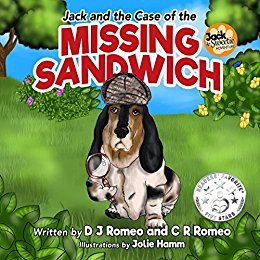 Jack and the Case of the Missing Sandwich (A Jack and Sweetie Mystery Book 1) by Dawn Romeo has Jack, a Basset Hound, on a very special case … the case of the missing peanut butter and jelly sandwich. Everyone knows how delicious a peanut butter and jelly sandwich is, but Jack would never take anything that belonged to someone else, and especially not food. Mr. Johnson had left his sandwich outside on his deck, gone back in to fetch a drink, and had come out again to discover the sandwich gone and a dog he thought was Jack walking down the driveway. When Sally, Jack’s owner, hears Mr. Johnson’s accusation she is naturally very disturbed, as is Jack. Sally springs to Jack’s defence, but Mr. Johnson is adamant that Jack is the culprit. This is a case that must be investigated and it’s going to take all Jack’s sleuthing skills to discover the clues leading to the real thief. Will Jack solve the crime and clear his name? Is it possible there’s another dog in the neighbourhood who looks like Jack?
Jack and the Case of the Missing Sandwich (A Jack and Sweetie Mystery Book 1) by Dawn Romeo has Jack, a Basset Hound, on a very special case … the case of the missing peanut butter and jelly sandwich. Everyone knows how delicious a peanut butter and jelly sandwich is, but Jack would never take anything that belonged to someone else, and especially not food. Mr. Johnson had left his sandwich outside on his deck, gone back in to fetch a drink, and had come out again to discover the sandwich gone and a dog he thought was Jack walking down the driveway. When Sally, Jack’s owner, hears Mr. Johnson’s accusation she is naturally very disturbed, as is Jack. Sally springs to Jack’s defence, but Mr. Johnson is adamant that Jack is the culprit. This is a case that must be investigated and it’s going to take all Jack’s sleuthing skills to discover the clues leading to the real thief. Will Jack solve the crime and clear his name? Is it possible there’s another dog in the neighbourhood who looks like Jack?What a charming story and a lovely little mystery that will get young readers guessing as to what really happened and who took the sandwich. Jack uses his detecting abilities to make an interesting discovery, and it’s one that leads to a surprising conclusion. There are some very good life lessons here for youngsters such as honesty being the best policy, not jumping to conclusions, staying calm if falsely accused, and not judging someone by appearances. Other themes include forgiveness and saying sorry, and owning up if one has done something wrong. Delightful illustrations by Jolie Hamm will keep young readers interested while being read to by a parent of caregiver. You don’t have to be a Basset Hound owner to totally love Jack, and young readers can look forward to more adventures and detective mysteries since this is book one in the series.
Published on January 30, 2018 06:31



